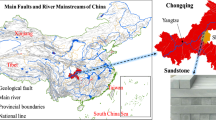Conclusions
1. As compared with corresponding solutions of the theory of elasticity, significant stress concentration is observed in compacted and loose sandy beds under any vertical load along the central vertical of rectangular plates. The degree of stress concentration depends on the properties of the medium (the density of the sand), the shape of the plate (the relationship between the dimensions of its sides), the external load, and, evidently, on a number of other factors. In the cases under consideration, the stresses increased nearly proportionally to the load (simple loading).
2. Maximum vertical deformations of the sandy bed under small loads occur directly at the lower surface of the plates. As the load increases, maximum deformation appears at a certain depth below the lower surface of the plate. The relation between stresses and relative vertical deformations is nonlinear over the entire range of load variation.
3. The more precisely defined results of study of the stress-strain state of the bed make it possible to evaluate more reliably the validity of existing and newly developed theoretical solutions employed in designing beds from first and second groups of limiting states.
Similar content being viewed by others
Literature cited
Construction Norms and Regulations II-15-74. Foundation Beds for Buildings and Structures [in Russian], Stroiizdat, Moscow (1975).
A. A. Grigoryan, "The problem involving the further development of soil mechanics," Osn., Fundam. Mekh. Gruntov, No. 6 (1978).
A. P. Krivorotov, "On the density of a sand bed in the stressed state," in: Proceedings of the Novosibirsk Institute of Railroad Engineers [in Russian], No. 28 (1962).
V. K. Fedorov and A. P. Krivorotov, "The character of stress distribution in a sand bed under flexible and rigid plates placed on its surface," in: News of the Universities. Construction and Architecture [in Russian], No. 10 (1971).
A. P. Krivorotov and V. A. Babello, "Errors in readings taken from flexible soil dynamometers under conditions of plane soil strain," in: News of the Universities. Construction and Architecture [in Russian], No. 3 (1978).
V. A. Babello and A. P. Krivorotov, "Effect of the form of the stressed state of a medium on the readings of soil dynamometers," in: News of the Universities. Construction and Architecture [in Russian], No. 5 (1978).
G. A. Skormin and M. V. Malyshev, "Experimental investigation of stress distribution in a sand bed under a circular foundation during a load increase," Osn., Fundam. Mekh. Gruntov, No. 5 (1970).
A. P. Krivorotov, "Results of the computation of foundation settlenents with allowance for variation in the soil's deformation characteristics," in: News of the Universities. Construction and Architecture [in Russian], No. 3 (1977).
Yu. A. Rogatin and Yu. N. Galin, "The mechanical properties of a sandy soil at various depths," Osn., Fundam. Mekh. Gruntov, No. 1 (1975).
V. P. Kamenev and A. P. Krivorotov, "Shallow foundations in rewetted deep embankments," in: News of the Universities. Construction and Architecture [in Russian], No. 2 (1979).
Additional information
Novosibirsk Civil Engineering Institute. Translated from Osnovaniya, Fundamenty i Mekhanika Gruntov, No. 3, pp. 24–27, May–June, 1981.
Rights and permissions
About this article
Cite this article
Krivorotov, A.P., Babello, V.A. Results of investigation of the stress state of a sandy bed for rigid plates. Soil Mech Found Eng 18, 117–122 (1981). https://doi.org/10.1007/BF01711215
Issue Date:
DOI: https://doi.org/10.1007/BF01711215




